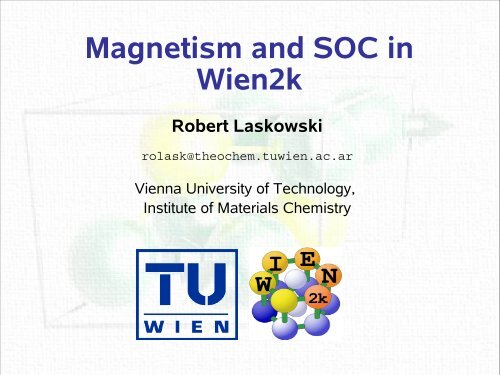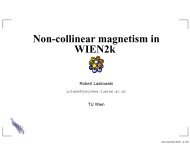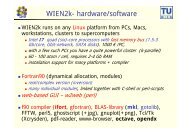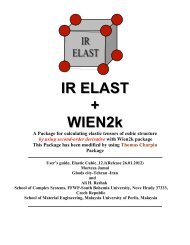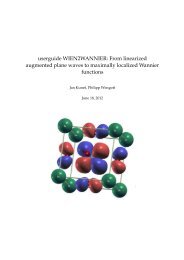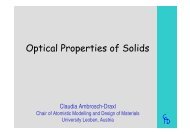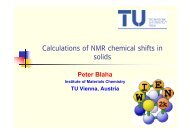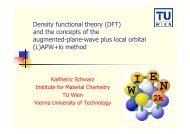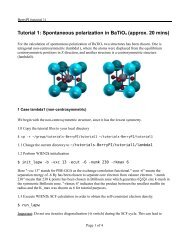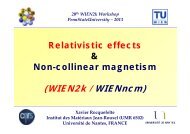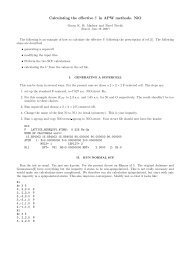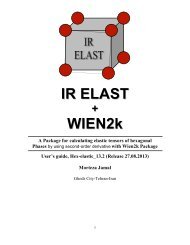(spin-orbit) and - WIEN 2k
(spin-orbit) and - WIEN 2k
(spin-orbit) and - WIEN 2k
- No tags were found...
Create successful ePaper yourself
Turn your PDF publications into a flip-book with our unique Google optimized e-Paper software.
Magnetism <strong>and</strong> SOC inWien<strong>2k</strong>Robert Laskowskirolask@theochem.tuwien.ac.arVienna University of Technology,Institute of Materials Chemistry
SCOPE●magnetism in Wien<strong>2k</strong>– collinear <strong>spin</strong>s (ferro, ferri, antiferro-magnets)– non-collinear <strong>spin</strong> (any arrangements),●introduction to WienNCM<strong>spin</strong>-<strong>orbit</strong> coupling (SOC) in Wien<strong>2k</strong>NCM & SOC in Wien<strong>2k</strong>wien<strong>2k</strong> workshop 2006 - p2
Pauli HamiltonianH P=− ħ2m ∇2 V ef B ⋅ B ef ⋅l ●●2x2 matrix in <strong>spin</strong> space, due to Pauli <strong>spin</strong> operatorswave function is a 2-component vector (<strong>spin</strong>or)<strong>spin</strong> upcomponentH P 1 2 = 1 2<strong>spin</strong> downcomponentNCM & SOC in Wien<strong>2k</strong>wien<strong>2k</strong> workshop 2006 - p3
Pauli HamiltonianH P=− ħ2m ∇ 2 V ef B ⋅ B ef ⋅l electrostaticpotentialmagnetic field<strong>spin</strong>-<strong>orbit</strong> coup.V ef=V extV HV xcB ef=B extB xcHartree termexchange-correlationpotentialexchange-correlationfield●exchange-correlation potential V xc<strong>and</strong> magneticfield B xcare defined within DFT LDA or GGANCM & SOC in Wien<strong>2k</strong>wien<strong>2k</strong> workshop 2006 - p4
Exchange <strong>and</strong> correlation●from DFT LDA exchange-correlation energy:E xcn , m =∫ n xcn , m dr 3local function of n <strong>and</strong> m● definition of V cx<strong>and</strong> B xc:V xc= ∂ E xcn , m ∂ n● LDA expression for V cx<strong>and</strong> B xc:Bxc= ∂ E xcn , m ∂ mfunctional derivativesB xc<strong>and</strong> m are parallelV xc= xcn , m n ∂ xcn , m ∂ nBxc=n ∂ xcn , m ∂ mmNCM & SOC in Wien<strong>2k</strong>wien<strong>2k</strong> workshop 2006 - p5
Non-collinear case●●H P=− ħ2m ∇ 2 V ef B⋅ B ef ⋅l direction of magnetization vary in space<strong>spin</strong>-<strong>orbit</strong> coupling is present− ħ2m ∇ 2 V ef BB z B B x iB y B B x−iB y − ħ2m ∇ 2 V ef B B z == 1 2 , 1, 2≠0●●solutions are non-pure <strong>spin</strong>orsnon-collinear magnetic momentsNCM & SOC in Wien<strong>2k</strong>wien<strong>2k</strong> workshop 2006 - p6
Collinear caseH P =− ħ2m ∇ 2 V ef B ⋅ B ef ⋅l ● magnetization in Z direction, B x<strong>and</strong> B y=0●<strong>spin</strong>-<strong>orbit</strong> coupling is not present− ħ2m ∇ 2 V ef B B z 00 − ħ2m ∇ 2 V ef BB z= = 10 , = 0 2 , ≠ ●●solutions are pure <strong>spin</strong>orscollinear magnetic momentsNCM & SOC in Wien<strong>2k</strong>wien<strong>2k</strong> workshop 2006 - p7
Non-magnetic caseH P =− ħ2m ∇ 2 V ef B ⋅ B ef ⋅l ● no magnetization present, B x, B y<strong>and</strong> B z=0●<strong>spin</strong>-<strong>orbit</strong> coupling is not present− ħ2m ∇ 2 V ef 00 − ħ2m ∇2 V ef== 0 , = 0 , ●solutions are pure <strong>spin</strong>ors= ●degenerate <strong>spin</strong> solutionsNCM & SOC in Wien<strong>2k</strong>wien<strong>2k</strong> workshop 2006 - p8
Magnetism <strong>and</strong> Wien<strong>2k</strong>●Wien<strong>2k</strong> can only h<strong>and</strong>le collinear or non-magnetic casesrun_lapw script:x lapw0x lapw1x lapw2x lcorex mixernon-magnetic casem=n −n =0NCM & SOC in Wien<strong>2k</strong>wien<strong>2k</strong> workshop 2006 - p9
Magnetism <strong>and</strong> Wien<strong>2k</strong>●Wien<strong>2k</strong> can only h<strong>and</strong>le collinear or non-magnetic casesrun_lapw script:x lapw0x lapw1x lapw2x lcorex mixernon-magnetic casem=n −n =0run_lapw script:x lapw0x lapw1 -upx lapw1 -dnx lapw2 -upx lapw2 -dnx lcore -upx lcore -dnx mixermagnetic casem=n −n ≠0NCM & SOC in Wien<strong>2k</strong>wien<strong>2k</strong> workshop 2006 - p10
Spin polarized calculations●runsp_lapw script (unconstrained magnetic calc.)– runs lapw1/2 for both <strong>spin</strong>s independently– case.scf contains extra information:●●●grep :MMT case.scf (for total moment)grep :MMI case.scf (for atomic moments)grep :HFF case.scf (for hyperfine fields)NCM & SOC in Wien<strong>2k</strong>wien<strong>2k</strong> workshop 2006 - p11
Spin polarized calculations●runsp_lapw script (unconstrained magnetic calc.)– runs lapw1/2 for both <strong>spin</strong>s independently– case.scf contains extra information:●●●●●grep :MMT case.scf (for total moment)grep :MMI case.scf (for atomic moments)grep :HFF case.scf (for hyperfine fields)runfsm_lapw -m value (constrained moment calc.)– for difficult to converge magnetic cases or simply to constrain amoment ( 2 Fermi-energies external magnetic field)runafm_lapw (anti-ferromagnetic calculation)– calculates only <strong>spin</strong>-up, uses symmetry to generate <strong>spin</strong>-dnNCM & SOC in Wien<strong>2k</strong>wien<strong>2k</strong> workshop 2006 - p12
Spin polarized calculations●●●runsp_lapw script (unconstrained magnetic calc.)runfsm_lapw -m value (constrained moment calc.)runafm_lapw (anti-ferromagnetic calculation)●●<strong>spin</strong>-<strong>orbit</strong> coupling can be included in secondvariational stepnever mix polarized <strong>and</strong> non-polarizedcalculations in one case directory !!!NCM & SOC in Wien<strong>2k</strong>wien<strong>2k</strong> workshop 2006 - p13
Non-collinear calculations●in a case of non-collinear <strong>spin</strong> arrangements WienNCM(Wien<strong>2k</strong> clone) has to be used– code based on Wien<strong>2k</strong> (available for Wien<strong>2k</strong> users)– structure <strong>and</strong> usage philosophy similar to Wien<strong>2k</strong>– independent source tree, independent installationNCM & SOC in Wien<strong>2k</strong>wien<strong>2k</strong> workshop 2006 - p14
Non-collinear calculations●●case of non-collinear <strong>spin</strong> arrangements WienNCM(Wien<strong>2k</strong> clone) has to be used– code based on Wien<strong>2k</strong> (available for Wien<strong>2k</strong> users)– structure <strong>and</strong> usage philosophy similar to Wien<strong>2k</strong>– independent source tree, independent installationWienNCM properties:– real <strong>and</strong> <strong>spin</strong> symmetry (simplifies SCF, less k-points)– constrained or unconstrained calculations (optimizesmagnetic moments)– SOC in first variational step, LDA+U– <strong>spin</strong> spiralsNCM & SOC in Wien<strong>2k</strong>wien<strong>2k</strong> workshop 2006 - p15
WienNCM - implementation● basis set – mixed <strong>spin</strong>ors (Yamagami, PRB (2000); Kurtz PRB (2001)interstitials:spheres: G =ei Gk ⋅r APW =∑G ∑lm A lmG u l B lmG ˙u l Y lm APW =G G Alm uG l Blm ˙uG l Clm u2, l Y lm = 10 , 0 1●real <strong>and</strong> <strong>spin</strong> space parts of symmetry op. are bounded– symmetry treatment like SOC always on– tool for setting up magnetic configurationm– concept of magnetic <strong>and</strong> non-magnetic atomsNCM & SOC in Wien<strong>2k</strong>wien<strong>2k</strong> workshop 2006 - p16
WienNCM implementation● sphere Hamiltonian: H =− ħ2m ∇2 V H so H orb H cAMA <strong>and</strong> full NCcalculationSOC in firstdiagonalizationV FULL=V V V V =V V 0AMAlH so= ⋅l =zl x−i l yl xi l y−l z0 V diagonal <strong>orbit</strong>al fieldconstraining fieldH orb=∑m m 'H c = B ⋅B c =∣m 〉 V mm '〈 m '∣ 00 ∣m 〉 V mm '〈m '∣0 B B cx−iB cy B B cxiB cy 0NCM & SOC in Wien<strong>2k</strong>wien<strong>2k</strong> workshop 2006 - p17
WienNCM – <strong>spin</strong> spirals●transverse <strong>spin</strong> wave=R⋅q●●generalized Bloch theorem– generalized translations– group of T nis AbelianRT n={−q⋅R n∣∣R n }T n k r =U −q⋅R k r R = k r efficient way for calculation of <strong>spin</strong>waves, only one unit cell is necessaryfor even incommensurate wave k r =e i k⋅r i q⋅re−i q⋅r2e2 u r u r NCM & SOC in Wien<strong>2k</strong>wien<strong>2k</strong> workshop 2006 - p18
WienNCM – case.inncm file●case.inncm – magnetic structure fileFULL0.000000 0.000000 0.00000045.00000 54.73561 0135.00000 125.26439 0-135.00000 54.73561 0-45.00000 125.26439 045.00000 54.73561 045.00000 54.73561 0315.00000 125.26439 0315.00000 125.26439 0135.00000 125.26439 0135.00000 125.26439 0225.00000 54.73561 0225.00000 54.73561 00.50000mixing forconstraining fieldU, magneticatomsO, non-magneticatomsq spiral vectorpolar angles of mmoptimization switchNCM & SOC in Wien<strong>2k</strong>wien<strong>2k</strong> workshop 2006 - p19
SOC in Wien<strong>2k</strong>
SOC in Wien<strong>2k</strong>●Non-relativistic limit of Dirac equation[ p22m V −p48m 3 c 2−ħ2 dV4m 2 c 2 dr∂∂ r 1 12m 2 c 2 rdVdr l s ] Φ=εΦSchrödingerEquationmass enhancement +Darwin term<strong>spin</strong>-<strong>orbit</strong> coupling●SOC mixes up <strong>and</strong> down states, j=l+s is good quantum numberj=l+s/2κ=-s(j+½)occupationls=-1s=+1s=-1s=+1s=-1s=+1s01/2-12p11/23/21-224d23/25/22-346f35/27/23-468NCM & SOC in Wien<strong>2k</strong>wien<strong>2k</strong> workshop 2006 - p21
Relativistic <strong>orbit</strong>al contraction●Au s <strong>orbit</strong>als (no SOC)• 1s contracts due to relativistic mass enhancement• 2s - 6s contract due to orthogonality to 1sM =m/1− v/c 2v proportional Z: Gold: Z = 79;M = 1.2 mNCM & SOC in Wien<strong>2k</strong>wien<strong>2k</strong> workshop 2006 - p22
SOC splitting of p states• Spin Orbit splitting of l-quantum number.• p 1/2(κ=1): markedly different behavior than non-relativistic p-state• u κ=1: non-zero at nucleusNCM & SOC in Wien<strong>2k</strong>wien<strong>2k</strong> workshop 2006 - p23
Relativistic <strong>orbit</strong>al expansion• Higher l-quantum number states exp<strong>and</strong> due to bettershielding of core charge from contracted s-states.NCM & SOC in Wien<strong>2k</strong>wien<strong>2k</strong> workshop 2006 - p24
<strong>orbit</strong>al contractionAu atomic spectra<strong>orbit</strong>al contraction<strong>orbit</strong>al expansion<strong>orbit</strong>al contractionSOC splitingNCM & SOC in Wien<strong>2k</strong>wien<strong>2k</strong> workshop 2006 - p25
SOC in Wien<strong>2k</strong>●<strong>WIEN</strong><strong>2k</strong> offers several levels of treating relativity:– non-relativistic: select NREL in case.struct (not recommended)– st<strong>and</strong>ard: fully-relativistic core, scalar-relativistic valence● mass-velocity <strong>and</strong> Darwin s-shift, no <strong>spin</strong>-<strong>orbit</strong> interaction– “fully”-relativistic:● adding SO in “second variation” (using previous eigenstates asbasis)●●●adding p-1/2 LOs to increase accuracy (caution!!!)Non-magnetic systems:– SO does NOT reduce symmetry. initso_lapw just generates case.inso<strong>and</strong> case.in2c.Magnetic systems:– symmetso detects proper symmetry <strong>and</strong> rewrites case.struct/in*/clm*NCM & SOC in Wien<strong>2k</strong>wien<strong>2k</strong> workshop 2006 - p27
SOC in Wien<strong>2k</strong>●●run(sp)_lapw -so script:x lapw1(increase E-max for more eigenvectors in second diag.)x lapwso(second diagonalization)x lapw2 –so –c (SO ALWAYS needs complex lapw2 version)case.inso file:WFFIL4 1 0 llmax,ipr,kpot-10.0000 1.50000 emin,emax (output energy window)0. 0. 1. direction of magnetization (lattice vectors)1 number of atoms for which RLO is added2 -0.97 0.005 atom number,e-lo,de (case.in1), repeat NX times0 0 0 0 0 number of atoms for which SO is switched off; atomsNCM & SOC in Wien<strong>2k</strong>wien<strong>2k</strong> workshop 2006 - p28
Thank you for yourattention


